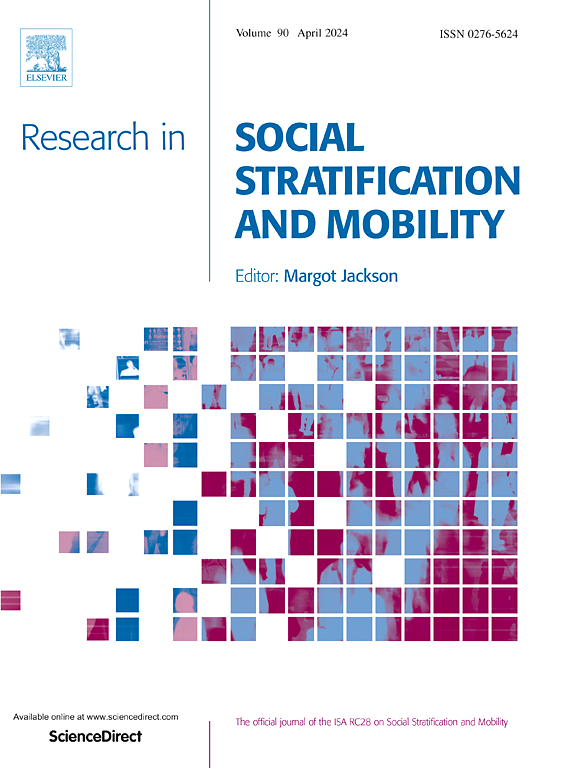His and hers earnings trajectories: Economic homogamy and long-term earnings inequality within and between different-sex couples
IF 2.7
1区 社会学
Q1 SOCIOLOGY
引用次数: 0
Abstract
Economic homogamy has important implications for gender inequality and for economic inequalities between households. However, the long-term association between spouses’ earnings is not well understood. This study reconceptualizes economic homogamy as a life course process rather than a static state of being that can be adequately captured at a single point in time. Using data from the National Longitudinal Survey of Youth 1979, I examine the association between spouses’ earnings trajectories over the course of 30 years of marriage to identify three distinct gender egalitarian earnings patterns among couples. 50 % of couples follow a Dual earner pattern, in which spouses follow similar, stable earnings patterns over time, 6 % of couples are Jointly mobile in that spouses’ earnings vary similarly and 5 % follow an Alternating earner pattern. A large minority of couples follow patterns of long-term specialization, with 34 % of couples following Male breadwinner patterns and 5 % following Female breadwinner patterns. Multivariate analysis reveals that gender egalitarian earnings patterns are stratified by couples’ socio-economic status at marriage: while advantaged couples follow Dual earner patterns comprised of two stable earners, disadvantaged couples follow egalitarian earnings patterns characterized by joint earnings instability. By taking a long-term approach, this study provides insight into the varied ways gender equality in earnings manifests among married couples and reveals an important and understudied dimension of economic homogamy: the concentration of economic stability and instability within couples.
他和她的收入轨迹:不同性别夫妇内部和之间的经济同妻制与长期收入不平等
经济上的一夫一妻制对性别不平等和家庭之间的经济不平等具有重要影响。然而,人们对配偶收入之间的长期联系还不甚了解。本研究将经济同妻重新概念化,将其视为一个生命过程,而不是一个可以在单一时间点充分捕捉到的静态状态。通过使用 1979 年全国青年纵向调查(National Longitudinal Survey of Youth 1979)的数据,我研究了婚姻 30 年中配偶收入轨迹之间的关联,从而在夫妻中发现了三种不同的性别平等收入模式。50%的夫妻遵循双职工模式,即夫妻双方在一段时间内遵循相似、稳定的收入模式;6%的夫妻属于共同流动模式,即夫妻双方的收入变化相似;5%的夫妻遵循交替职工模式。34% 的夫妇采用男性养家糊口模式,5% 的夫妇采用女性养家糊口模式。多变量分析表明,性别平等收入模式因夫妇结婚时的社会经济地位而分层:优势夫妇采用由两个稳定的收入者组成的双收入者模式,而劣势夫妇则采用以共同收入不稳定为特征的平等收入模式。通过采取长期研究方法,本研究深入探讨了已婚夫妇收入性别平等的不同表现形式,并揭示了经济同妻制的一个重要且未被充分研究的层面:经济稳定性和不稳定性在夫妇内部的集中体现。
本文章由计算机程序翻译,如有差异,请以英文原文为准。
求助全文
约1分钟内获得全文
求助全文
来源期刊
CiteScore
7.80
自引率
6.00%
发文量
46
期刊介绍:
The study of social inequality is and has been one of the central preoccupations of social scientists. Research in Social Stratification and Mobility is dedicated to publishing the highest, most innovative research on issues of social inequality from a broad diversity of theoretical and methodological perspectives. The journal is also dedicated to cutting edge summaries of prior research and fruitful exchanges that will stimulate future research on issues of social inequality. The study of social inequality is and has been one of the central preoccupations of social scientists.

 求助内容:
求助内容: 应助结果提醒方式:
应助结果提醒方式:


